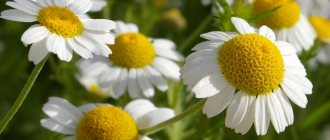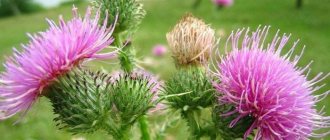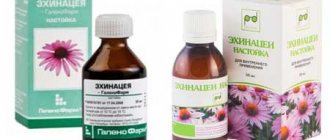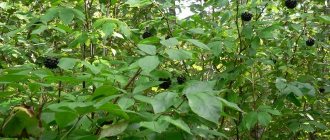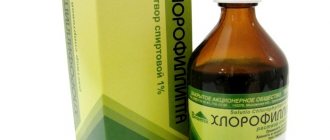Avicenna called chamomile the most useful medicine for exhaustion. Modern medicine has proven the healing properties of chamomile, which is widely used in the complex treatment of many diseases of the digestive and respiratory systems, skin diseases, and in the beauty industry. Interest in medicinal herbs is growing every year; every third medicine in Russia contains herbal ingredients, among which chamomile ranks high
Characteristics, types and distribution
Chamomile (Matricaria, “mother herb”, “Romanov flower”) is a low herb from the Asteraceae family. The plant has a branched stem 15–40 cm long, and the inflorescence in the form of hemispherical baskets does not exceed 20 mm in diameter. The thin root of the herb has the shape of a rod, and the leaves are strongly dissected and consist of thin lobes. The snow-white marginal flowers of Matricaria have a specific aroma, and the inner tubular flowers are colored yellow. The flowering period of the crop is May - October. Known species:
- Pharmacy (medicinal). The plant with a strong aroma and a bare stem is most popular among the population. It is easy to recognize pharmaceutical chamomile precisely because of its lack of pubescence. Grass grows over a wide area, with the exception of zones with excessively high and low thermal conditions.
- Odorous (fragrant, tongueless). Small baskets of this sunny flower are located on shortened extensions of the stem. The aroma of the plant is sharp and tart. Habitat: the Urals, the Far East and North America.
- Odorless. Chamomile is similar to this variety. However, three-ribs (in Latin, odorless chamomile - Tripleurospérmum inodórum) are completely odorless. Grows in North America and Eurasia.
The plant should be distinguished from its analogues in the form of cornflower and pyrethrum, which are distant relatives of the mother herb.
pharmaceutical camomile
Chamomile for children
Every mother knows very well that bathing a baby in water with a decoction of chamomile is very useful. And it’s easy to prepare such a healing bath - just take a tablespoon of dried flowers, pour boiling water (1 liter) over everything and leave to infuse. Usually 60 minutes is enough, but the main indicator of the readiness of the infusion for bathing the baby will be the flowers of the plant that have sunk to the bottom.
Please note: before pouring the chamomile infusion into a bath of water, be sure to strain the product - contact of the raw material with the baby’s skin is extremely undesirable, as it can provoke the development of severe irritation.
After such bathing with an infusion of chamomile, the child will experience deeper and more restful sleep, his delicate/sensitive skin will always be healthy, and the existing signs of irritation (sweating rashes) will disappear.
Chamomile also helps very well in the fight against intestinal colic in a child - for this, the baby is given tea from the plant in question. The product is prepared as follows:
- 1 teaspoon of dried chamomile flowers is poured with a glass of boiling water (300 ml);
- tea is infused for 30-60 minutes;
- the resulting product must be filtered and diluted with boiled water in a 1:1 ratio.
The result should be a slightly yellow drink, which children are given to drink 3-4 times a day immediately after meals in small quantities.
Please note: chamomile remedies should be prescribed to children by a specialist. And in any case, such measures cannot be abused - for example, you can bathe a baby in a bath with chamomile decoction no more than once a week.
Chemical composition
Let's analyze the most common species of Matricaria - chamomile. Its main components:
- vitamins (B1, B2, E, C and PP);
- saturated fatty acids;
- macroelements (potassium, calcium, phosphorus, sodium, magnesium);
- trace elements (iron);
- digestible carbohydrates (mono- and disaccharides);
- tannins and proteins;
- essential oil.
Chamomile is unique because it contains rare substances of plant origin. The glycoside increases appetite and bile secretion. Chamazulene in the plant enhances the effect of the essential oil and increases the heart rate.
Chamomile is unique in its chemical composition
Composition of chamomile
Chamomile officinalis, or chamomile, is an annual weed with a tall, hollow stem, branched from the base, with pinnately dissected leaves, externally reminiscent of a plant such as dill.
More than 40 components of natural compounds are included in its composition, including:
- ascorbic acid,
- a nicotinic acid,
- salicylic acid,
- fatty acid glycerides,
- tannins,
- mucus,
- pectins,
- Sahara,
- bitterness,
- Chamazulene is the main component of the essential oil in flowers.
More than 15 macro- and microelements, such as nickel, magnesium, iron, zinc, cobalt, copper, chromium, selenium, vanadium, are contained in chamomile flowers.
Application of the plant
When describing chamomile, we will focus on its use. In landscape design, this delicate flower is often used to create a “Russian garden”. It harmonizes perfectly with many plants. The English style involves a combination of large perennial garden daisies with cornflowers and poppies. A flowerbed in the French version is a neighborhood of Matricaria with wildflowers with a neatly trimmed lawn.
The best cosmetics as raw materials for creating hair rinses, face masks and all kinds of scrubs. It is also included in toothpastes for the prevention and treatment of periodontal disease. An extract from the plant is used to create perfumes, lotions and eau de toilette.
It is difficult to imagine herbal medicine without the “mother herb”. There are some restrictions on the use of Matricaria. It is forbidden to use it together with ginseng, ginger, aloe and garlic, which have an invigorating effect.
Chamomile is included in hair rinses, face masks and other cosmetics.
External use of chamomile
The external use of chamomile infusion is very diverse. It is used in the form of gargles for various inflammatory processes in the throat, mouth and nose, as well as in the form of inhalations for inflammation of the upper respiratory tract.
This infusion is used to wipe the eyes for conjunctivitis. Using a compress using chamomile infusion, you can reduce signs of eye fatigue, improve the color of the skin under the eyes, and also relieve irritation on the eyelids. Wiping the face (for example, during makeup removal) using chamomile infusion helps rejuvenate the skin.
Rinsing your hair with chamomile infusion helps nourish and strengthen your hair. Hair becomes shiny and silky. Chamomile infusion also helps get rid of dandruff, normalizes the functioning of the sebaceous glands of the head and neutralizes the negative effects of substances included in shampoos.
Chamomile infusion can be added to the bath. You can rinse your entire body with it. This will cleanse the sebaceous glands, relieve minor irritations and minor inflammations in all areas of the body. The combination of a bath with infusion and steaming helps with chronic diseases of the nasopharynx.
There are currently quite popular medicines with the addition of chamomile extract. One of them is the drug rotokan, which is used mainly for diseases of the oral mucosa.
Medicinal properties and harm
A representative of the Astrov family brings benefits when making the following diagnoses:
- respiratory tract problems;
- gastritis and pancreatitis;
- skin damage;
- stomatitis;
- migraine;
- flatulence;
- haemorrhoids;
- cystitis;
- bleeding after childbirth;
- painful menstruation;
- PMS;
- toothache;
- poor appetite;
- increased excitability;
- insomnia.
Contraindications for the use of chamomile herb:
- allergy;
- predisposition to diarrhea;
- anacid gastritis;
- pregnancy;
- lactation;
- use of aspirin and blood thinners.
In other cases, a representative of the Astrov family is absolutely safe for the human body. To be on the safe side, an infusion of it is dripped onto the inside of the arm and awaits the result of an allergy test. The use of pharmaceutical chamomile and its use for medicinal purposes should be dosed. Otherwise, the person will begin to suffer from regular migraine attacks.
The use of pharmaceutical chamomile should be dosed
Internal use of chamomile
For internal use, chamomile is used as a medicinal tea. Chamomile tea can enhance the secretion of gastric juice and bile, stimulate appetite, while enveloping the intestines itself, reducing its sensitivity and irritation.
Chamomile tea helps relieve pain and spasms, reduces swelling of the gastric mucosa, and, thanks to its adsorbing properties, absorbs toxins and waste from the gastrointestinal tract. In this regard, chamomile tea is often used for various gastrointestinal disorders, such as colitis, diarrhea, gastritis, flatulence. In addition, chamomile tea promotes rapid healing of the duodenum with ulcers.
Chamomile tea also has a calming effect. It can relieve tension, calm nerves and make it easier to fall asleep.
Chamomile tea can be drunk as a diaphoretic and antipyretic, as well as to strengthen the immune system during infectious diseases such as ARVI, sore throat, influenza, etc.
There are a huge number of herbal infusions, including chamomile inflorescences and other medicines, as well as dietary supplements, used for internal use to eliminate certain health problems.
Collection, preparation and storage
Chamomile should be collected at the end of June, when it gains full strength. It is recommended to pick it in a field or at the edge of a forest. The main collection conditions are dry weather and morning time. Our ancestors believed that at dawn the gifts of nature could bring the greatest benefit. If you want to take a fragrant bath, pick off all the grass and dry the chamomile in bunches. For inhalations and lotions, only the inflorescences are cut.
When asking how medicinal chamomile is prepared, you should turn to folk experience. You can buy miracle raw materials at any pharmacy, but the pleasure of the process will disappear. Place it in the fresh air, but without contact with direct sunlight.
When deciding how to dry chamomile, you should think about its storage. It is stored in a room where moisture does not enter. Raw materials are stored separately from other herbs, which may later cause an allergic reaction in humans.
Medicinal chamomile is harvested at the end of June
Description of the plant
There are several types of chamomile, each of which has healing properties to varying degrees:
- pharmacy;
- odorless;
- chamomile.
Only chamomile, which has more pronounced medicinal properties, is included in the state register of medicinal plants. All varieties are used in folk medicine. Chamomile has synonymous names: medicinal and peeled, translated into Latin - matricaria. Only flowers are used as raw materials. They are collected in May and June in dry weather. In the middle and end of the season, chamomiles do not lose their beneficial properties, but their presentation deteriorates after drying. Dried inflorescences have a shelf life of 12 months.
Chamomile parts:
- thin tap root with shoots;
- long branched stem about 30 cm high;
- leaves are divided into numerous thin, soft segments;
- small flowers, about 2 cm, located at the ends of the stem branches, have white petals and a golden-yellow core;
- The fruit of the plant is an achene.
All parts have a characteristic odor. This field plant is common in the middle zone and in the south, growing in fields, open places in forests, along roads, and in wastelands. It is rarely found as a weed, as it cannot withstand the competition of its neighbors. When harvesting, leave 20% of the flowers so that the herb does not disappear.
For medicinal purposes, chamomile is collected in places far from cities and highways. Raw materials are checked for the presence of heavy metals and other toxic substances. In Russia, the leader in growing chamomile is the Krasnodar region.
Medicinal properties
Useful qualities of chamomile:
- relieves spasm of smooth muscles;
- relieves inflammation;
- disinfects;
- calms the nervous system;
- some painkillers.
Chamazulene, a component of essential oil, removes inflammation, has an anti-allergenic effect, and promotes tissue healing.
Chamomile stimulates the production of digestive juices. Due to the content of bitterness and tannins, the plant increases the production of bile, relieves spasm of the sphincters of the biliary tract, improving the outflow of secretions from the biliary tract (gallbladder and ducts). Thanks to its antioxidant properties, chamomile protects red blood cells and liver tissue in case of toxic poisoning and alcohol consumption. Chamomile has an anti-inflammatory effect in the complex treatment of diseases of the genitourinary system of women and men. Indications for taking chamomile are biliary dyskinesia and bile sludge. Flavonoids in the extract have an antitumor effect.
The antimicrobial properties of chamomile and other plants are being studied. The decrease in the effectiveness of synthetic antibiotics and the development of resistance of microorganisms to them increases the importance of research into the antibacterial properties of medicinal herbs. A.S. Sheremetyeva in her scientific work “Comparative analysis of the antimicrobial activity of infusions of calendula officinalis and chamomile” revealed the antistaphylococcal effect of both plants.
Chemical composition
The composition of matricaria includes macro and microelements:
| Item name | Content per 1 g (mg) |
| potassium | 41,8 |
| calcium | 8,3 |
| magnesium | 3,1 |
| iron | 0,3 |
| manganese | 0,29 |
| copper | 0,78 |
| zinc | 0,8 |
| iodine | 0,07 |
When chamomile flowers are brewed, 90% of the elements go into an aqueous solution.
The plant contains salicylic, nicotinic, ascorbic acids, and bitterness. Phytosterol, gum, tannins. Essential aromatic oil makes up 0.85% of the raw material and includes 48 components.
However, the content of the drug depends on the method of processing the raw materials and differs from the composition of the original plant.
Contraindications and side effects
Chamomile is a medicine. Despite its plant origin, its use should be agreed with a doctor. Preparations with chamomile are not recommended during pregnancy and breastfeeding; they often have age restrictions for children.
Despite its antihistamine properties, the plant can cause an allergic reaction. When using for the first time, it is better to take the minimum dose to make sure that there are no signs of individual intolerance.
Alcohol solutions can affect your overall health, causing dizziness, nausea and vomiting. Chamomile extract sometimes causes headaches. It is not recommended for use in the treatment of children under 3 years of age, as well as patients with psoriasis, epilepsy, cancer, Parkinson's disease,
How to prepare and store?
When collecting raw materials yourself, it is important to choose an environmentally friendly place away from cities, industrial facilities and highways. The weather should be dry for several days before harvesting. Only the inflorescences that have just bloomed are plucked from the plant. Drying is done in the fresh air in the shade. The flowers are placed on clean paper, parchment in a thin layer. The raw materials are not stirred so that the inflorescences remain intact.
Like all plants containing aromatic oil, it is better to store matricaria flowers in a sealed glass container, this will slow down the evaporation of beneficial substances. Over time, raw materials lose their medicinal properties. It is better to attach a label to the jar indicating the time of collection of the herb.
The shelf life of dried flowers is 12 months.
Forms of release of drugs
Chamomile can be purchased at the pharmacy in the following form:
- dry raw materials separately and as part of collections;
- chamomile tincture containing alcohol;
- chamomile oil;
- in tablets and sprays.
Dried flowers can be packaged in small filter bags designed for brewing as tea.
How to brew chamomile?
Distinguish between internal and external use of a natural component. However, the cooking scheme itself is not much different in both options. The hot method involves infusing the herb for 15 minutes, straining it and further cooling the liquid. The dosage in this case is strictly individual depending on the existing pathology.
The cold cooking method requires more time. The infusion is aged for 8 hours, so it is less popular compared to the first option. The main condition is not to boil the grass! Many of its healing qualities disappear during aggressive heat treatment.
There is a cold and hot way to brew chamomile
What herbs can be added
It is not necessary to use exclusively chamomile for making tea and infusions. At home, you can prepare healthy and very pleasant-tasting drinks by combining chamomile with:
- lemon balm;
- mint;
- yarrow;
- St. John's wort;
- valerian;
- calendula.
So, stomach erosion will heal faster if you mix 1 tbsp. spoon of yarrow, chamomile, mint and lemon balm, pour a liter of boiling water, leave for about 3 hours and drink several sips each time half an hour before meals.
St. John's wort copes well with inflammation, valerian relieves spasms, yarrow has proven itself to be an excellent antimicrobial agent (it helps fight Helicobacter pylori).
Using chamomile for gastritis together with these herbs can shorten recovery time. The stomach recovers faster after an illness, the production of hydrochloric acid is normalized, food is better digested, motor skills are normalized, and stool improves.
Everyone chooses their own method of use - some prefer to prepare a decoction, some like brewed chamomile, and some “compose” chamomile tea according to their own recipe, combining it with other herbs.
Whatever method you choose, you should remember: chamomile is great as an adjuvant, but in no case does it replace drug treatment for the stomach. It smoothes out symptoms and strengthens the body's defenses, giving it the opportunity to quickly cope with the disease.
If you experience any unpleasant sensations in the stomach area, you should consult a doctor, undergo a comprehensive examination and follow the instructions given by him. And for gastritis, chamomile will serve as a catalyst for recovery.
Recipes
After studying the medicinal properties and contraindications, “Romanov Tsvet” is used as follows:
- Gastritis. 2 tbsp. of yellow perennial chamomile, pour 150 ml of boiling water and infuse for 15-20 minutes. 50 ml 3 times a day for a week is enough to eliminate spasms during gastritis.
- Problems with the pancreas. For pancreatitis, the duration of therapy is extended to 10 days, 1.5 tbsp. l. herbs are poured into 200 ml of hot water and infused for 10-15 minutes. Take 2 tsp of healing liquid. three times a day.
- Tonsillitis. Dissolve 1 tbsp in 400 ml of boiling water. soda and add 1 tbsp. chamomile to treat a sore throat. Inhalation is carried out 2 times a day for 15 minutes for 2-3 days. Chamomile for cough will help with the same procedure for a week.
- Rheumatism. In this case, a bath with the addition of 20 g of raw materials per 1 liter will be beneficial for the body. boiling water The duration of water procedures is 20 minutes. Warming black tea with chamomile for rheumatism will also not hurt.
- Bruises. A lotion of 3 tbsp steamed in a quarter glass will help eliminate the problem. l. flowers. It is applied for half an hour and the bandage is secured with a bandage.
- Prickly heat. Chamomile for children is used not only in the form of purchased powders. Decoction of 1 tbsp. l. natural raw materials per 1 liter. boiling water will eliminate irritation on the baby’s delicate skin. Chamomile for babies will be useful for a runny nose, when after two drops of healing infusion per day for 2 days, the baby’s problem will be resolved. The main condition is a preliminary consultation with a pediatrician.
- Candidiasis. Chamomile for thrush is useful for douching. 2 tbsp. l. plants pour 1 liter. boiling water The infusion is administered after it has cooled into the vagina (preferably in the bathroom with legs raised). Washing with chamomile is also recommended in this case.
- Cystitis. Problems with the genitourinary system are solved with 1 tbsp. l. raw materials per 400 ml of boiling water. For cystitis, the mother herb is used in combination with hop cones and yarrow in the same proportion.
- Painful menstruation. For periods that cause significant discomfort, brew chamomile, St. John's wort, immortelle and birch buds. The recipe involves using 5 g of each herb per 250 ml of water. Infuse the drink for 20 minutes and drink half an hour before eating. If you are wondering whether it is possible to douche during menstruation, you should consult a gynecologist.
- Conjunctivitis. Lotions in the form of compresses for the eyes will help when using tea tincture with chamomile. 1 tbsp. l. The flowers are steamed in 200 ml of boiling water for half an hour. A warm lotion is applied to the inflamed area.
- Lung problems. Chamomile for tuberculosis is effective only in terms of accompanying therapy. To make breathing easier, the infusion is steamed in 250 ml of boiling water in the proportion recommended by the doctor.
Warming black tea with chamomile helps with rheumatism
Planting and caring for garden perennial chamomile and collecting wildflowers is a responsible undertaking. The process itself is quite simple, but you should follow the recommendations. Anyone can grow daisies and use them for their intended purpose, so we should wish everyone success.
How to make chamomile tea
Despite the fact that chamomile tea consists of 97.5% water, the remaining amount is enough to contain the necessary vitamins and microelements.
To prepare chamomile tea, you need two teaspoons of raw materials and water.
- You need to pour the mixture into the kettle.
- Boil the tea.
- Let the finished drink brew for 20 minutes.
This tea has a bitter taste. For this reason, chamomile mixture can be combined with different types of tea. This will not only improve the taste, but also add beneficial properties to the drink.
Chamomile tea goes well with mint and lemon.
You can make chamomile tea with mint, lemon and apples.
- An apple is added to the heated kettle, cut into small pieces.
- You need to pour a little chamomile into boiling water.
- After this, the tea should be allowed to steep for a few minutes.
- The tea needs to be strained.
- Add mint and lemon. You can add honey to improve the taste.
You can drink this tea in the morning. Then, it tones the body and energizes you for the whole day.
Contraindications
Like any medicine, chamomile has a number of contraindications:
- allergy to plant components;
- pregnancy, with caution during lactation;
- presence of mental disorders;
- increased acidity of gastric juice;
- chronic diseases;
- continuous intake of medications vital for maintaining health;
- in the form of douching - after reaching 40 years of age, during the menstrual cycle, in the first month after a miscarriage, childbirth, or surgery.
In case of an overdose, a person may feel irritation, headache, nausea, cough, diarrhea, dizziness, and hoarseness of voice.
Chamomile has a strong healing effect on the human body. It is important to adhere to the recommended amount of components when preparing medicinal products that contain it, and not to exceed the dosage and duration of use.
Antispasmodic effect
This effect of chamomile is a consequence of its relaxing, sedative effect. It is due to the relaxation of the intestinal muscles that spasms occur, which cause abdominal pain.
Chamomile acts similarly on the muscles of the uterus, due to which in women its preparations can relieve pain in the lower abdomen during menstruation.
The carminative properties of chamomile are partly associated with the antispasmodic effect. By relaxing the intestines, its preparations promote the rapid passage of food bolus and feces, along with which gases are released more easily. Therefore, chamomile is useful for flatulence: its use helps relieve the rectum of accumulated gases, reducing the feeling of bloating and heaviness in the abdomen.
Chamomile decoction - how to prepare and how to take
There are several ways to prepare chamomile decoction, which is most often used for treatment and preventive purposes. It is important to use only high-quality plant materials; they should not contain spoiled particles that have an unpleasant odor. It is recommended to purchase the product at a pharmacy, this will ensure that there will be no troubles after treatment. If you use homemade raw materials, be sure to follow all storage rules and regularly check whether they are damp.
Preparation of the decoction:
- 40 gr. send vegetable raw materials into enamel dishes.
- Pour boiling water (180-200 ml) over the flowers of the plant.
- Wait a few minutes and place the container in a water bath.
- Let the composition simmer for half an hour.
- Filter the liquid through a gauze cloth folded several times.
- If necessary, add a little more boiled water to restore the original volume.
Take only 80 ml at a time. Store in a cool place for no more than 2 days.
Reviews
Irina: I treat any digestive problems with chamomile. Helps both me and the children. Even infants are recommended to use a decoction to eliminate colic and bloating, let alone adults. I have a whole bed of chamomile growing at my dacha, and I collect flowers from it throughout the summer.
Olga: I discovered that I was allergic to chamomile quite by accident. I read in a magazine that if you drink a glass of tea in the evening before bed and in the morning on an empty stomach, you can significantly improve the condition of your facial skin. After a few days of such procedures, even more rashes appeared on the face, and the skin began to itch...
Dmitry: Grass is a herb, it cannot be effective without drugs, so you can only indulge in it, but not cure it.
Oksana: I give this wonderful flower only pluses. It makes a very aromatic tea. He saves our family from colds and viruses, tummy problems in children, and stands guard over youth and beauty. It has a wide range of applications.
Harm and contraindications
Chamomile tea is a leader among other medicinal drinks of plant origin. It was described by ancient healers, considering it one of the strongest natural medicines. In addition to its benefits, it has a minimum of contraindications.
Harm from chamomile tea may occur in the following cases:
- if you are allergic to the plant;
- with frequent use in large quantities;
- for large stones in the kidneys or gall bladder.
For some, tea causes indigestion and even diarrhea. It should not be taken at the same time as blood thinners or diuretics. Contraindications apply to people who systematically use sedatives and sedatives; chamomile enhances their effect. Otherwise, the plant does not have serious negative effects on human well-being.
Decoctions using chamomile, sage and mint
- From periodontal disease. Mix chamomile flowers, sage and mint in equal quantities, one tablespoon at a time. Pour in 300 ml of water and bring to a boil. Pour into a thermos and leave for eight hours. Rinse your mouth with a filtered solution up to five times a day.
- As an adjuvant in the complex treatment of diseases of the liver and biliary tract. The collection is prepared from chamomile, sage, mint, wormwood, caraway and yarrow in equal proportions. 2 tablespoons of the resulting mixture are poured into 300 ml of water and brought to a boil. Place in a thermos. After twelve hours the medicine is ready. The solution is filtered and drunk half a glass after each meal, about an hour later.
- For taking baths when insomnia develops as a result of nervous strain. A collection is prepared from the herbs of sage, chamomile, mint, thyme and lavender in equal quantities of 5 tablespoons. The resulting mixture of medicinal herbs is poured with a liter of water and simmered over low heat for five minutes. The resulting broth is filtered and poured into a bath filled with warm water at approximately 40 degrees Celsius. The duration of the procedure should be fifteen minutes. Baths are taken daily before bed.
- Cleansing decoction for facial skin. A decoction is prepared using chamomile and linden flowers, sage and mint leaves, dill herb, and rose hip flower petals. The decoction has a moisturizing and cleansing effect and nourishes the skin. The aseptic action relieves inflammation. Promotes regeneration of epidermal cells. It helps well with skin problems, relieves dryness and inflammation.
Doctor: Olga Shishkina ✓ Article checked by doctor
Share with friends or Save for yourself!
5 / 5 ( 13 votes)
The other side of the coin: when beneficial properties turn into harmful ones
It is important to understand that the medicinal properties of chamomile can cause side effects if it is used incorrectly or if its drugs are abused.
For example, when chamomile is abused as a sedative, there may be general inhibition of the nervous system, decreased muscle tone, lack of attention, and general physical weakness. Also, in very large quantities or in high concentrations, chamomile can cause headaches.
It is also known that by relaxing the intestinal muscles, chamomile increases the symptoms of diarrhea and negatively affects the condition of people who are generally prone to diarrhea. This is partly why chamomile tea is not recommended for infants: diarrhea can be extremely dangerous for them.
In some cases, intestinal relaxations are even necessary, but in case of diarrhea it is better to avoid them.
And the effect of chamomile on the activity of the muscles of the uterus during pregnancy can provoke a miscarriage or premature birth, and here the cost of an error in the prescription and use of chamomile is very high.
It is believed that coumarin from chamomile flowers can cause an anticoagulant effect and lead to bleeding. This, however, is more of a hypothetical calculation, since the coumarin content in chamomile is low and numerous other side effects of chamomile will already have developed before it causes undesirable effects.
In general, the medicinal properties of chamomile make it possible to use it in the treatment of many common diseases, which has led to its wide popularity and greater popularity than other traditional medicines.
Unique properties of chamomile
The plant is unique in that it contains 18 out of 20 micro- and macroelements necessary for life support. And this is one of those plants that does not contain toxic substances.
The essential oil contained in the active substances of the plant includes the component chamazulene, which has healing powers. It contains nicotinic, salicylic, ascorbic and other acids, bitterness, gums, carotene, polysaccharides and other substances. And all this gives it incredible healing properties.
Chamomile is a strong immunosuppressant and is an analgesic, anticonvulsant and sedative. Its drugs are good for treating nervous, hysterical, restless, angry and intolerant people. The action of chamomile has a positive effect on the emotional background and nervous system after suffering anger, frustration and major troubles.
It has a good effect on the nervous system. This is a precious remedy used for severe painful susceptibility of the sensory and motor nerves, which manifests itself in spasms and convulsions. Pregnant women and young children often suffer from this. Used for neuroses and neuritis of the trigeminal nerve. Normalizes intestinal motility.
It tones and calms. It is used for severe nicotine addiction and excessive coffee consumption, and for heavy mental stress that causes overstrain in brain activity. Healing infusions and chamomile tea will help relieve fatigue, improve memory, sleep and performance.
It is an antiseptic that has an anti-inflammatory effect. For colds, it slows down the proliferation of microbes in the body. It has a diaphoretic effect, reduces fever, strengthens the immune system.
The brewed herb is used in the treatment of infectious and viral diseases of the respiratory system, dilutes and removes mucus. Used for sore throat, laryngitis, tonsillitis. For these diseases, tea is indicated, and decoctions are used for inhalation and gargling. With its help you can cure sinusitis. This plant perfectly relieves the body of bacterial toxins.
Chamomile tones and improves digestion. She treats gastrointestinal diseases, hemorrhoids, anal fissures. Eliminates constipation, colic, flatulence. Used in the treatment of liver, spleen, kidneys, bladder. Using chamomile tea with the addition of butter, sand and stones are gently removed from the liver and gall bladder. It has a choleretic effect, treats cholecystitis, stimulates the flow of bile, relieves attacks of nausea and heartburn.
The plant removes poisons and toxins from the body, which promotes rejuvenation. To do this, it is recommended to drink chamomile decoction in between meals.
Chamazulene, which is part of chamomile, reduces allergic effects and enhances tissue regeneration. It is recommended to use herbal teas, including chamomile, for allergic reactions to food, all kinds of odors, and medications. For gastritis and colitis - to relieve allergic swelling of the gastric mucosa. Used in the treatment of wounds, eczema and burns with x-rays. Used as an anthelmintic.
The Latin name for chamomile matrix is “uterus”. This is the best remedy for childbirth and pathological processes. Chamomile tea, drunk after the water breaks in a woman in labor, speeds up and makes childbirth painless. It is used to treat mastitis.
Even in ancient times, it was used to treat female diseases: colpitis and vaginitis, candidiasis, inflammatory processes of the ovaries and uterus, and tumors in them. Herbal preparations relieve painful conditions during menopause. Another name for chamomile is “hen party.” Decoctions and infusions from this plant helped young girls and women with painful menstruation.
When using chamomile juice, men's sexual power increases. If you add yarrow juice (1:1) to chamomile juice and consume this mixture in ½ tsp. 2 times a day, impotence can be avoided.
Chamomile has also found its use in psychology. It protects against the negative influence of negative energies, especially from night terrors. To do this, a handful of dried flowers are sewn into a fabric bag and placed at the head of the bed, then sleep becomes restful. It helps children well, protects them from sleep and protects them from night visions and fears. It is useful to give chamomile tea to children and drink it yourself after visiting unwanted guests.
To free yourself from negativity and develop positive thinking, a person can resort to the help of a living chamomile flower. For each flower petal, you need to identify some kind of negative thought, negative thinking pattern or insurmountable situation. When tearing off the designated petal, you need to clearly imagine how the negative goes away, how this problem is solved, and outline possible options for solving it. A positive attitude when performing this exercise will be clearly recorded in the mind.
The beauty of the flower gives beauty to women too. In cosmetology it is used to strengthen hair roots during hair loss and to treat seborrhea. An ointment made from a strong decoction of chamomile and honey can lighten dark hair or revitalize dull hair. If you add coffee or strong tea to a strong herbal decoction, your hair will become darker after rinsing with this product. If the hair is dark, it will acquire a rich color (depending on the added component).
The plant is used to care for the skin of the face, hands and body. Rub the face with ice cubes from chamomile decoction to tighten pores and remove flaking of the skin. Rubbing your hands with ice cubes can rejuvenate your hand skin. To rejuvenate facial skin, remove wrinkles and remove excess deposits of subcutaneous fat, use a paste of chamomile flowers crushed into flour, steamed in hot water (not boiling water). The container must be carefully closed with a lid. The essential oils that the plant contains will speed up metabolism in problem areas, burn fat deposits and evaporate moisture.
Despite the wide range of medicinal qualities, chamomile also has contraindications for use.
- Constant use of drugs, infusions or teas from its flowers can lead to iron deficiency anemia, as over time they begin to interfere with the absorption of iron from the digestive system into the blood.
- Although chamomile is not an allergenic (contains chamazulene) and hypersensitivity to it is rare, an allergy to it is still possible. This mainly occurs in people over 35 years of age and in infants.
- With excessive use of chamomile preparations, women may experience severe relaxation of the muscles of the uterus, which will cause menstrual disorders, and in pregnant women - complications with bearing the fetus.
What diseases are treated with chamomile?
In many developed countries of our planet, chamomile is successfully used both in medicine and in cosmetics, as well as in beauty salons . Its medicinal properties are so wide that this plant has earned the title of record holder among all other medicinal herbs.
In combination with medicinal drugs, the plant is used to treat gastrointestinal diseases:
- Gastritis, enterocolitis and stomach ulcers;
- Bloating;
- Colitis;
- Cholecystitis.
Chamomile is used directly orally for various gynecological diseases, asthma , liver and biliary tract diseases, as well as to alleviate migraines .
It can also be used externally. It helps with burns and frostbite, allergic itchy dermatosis and eczema, toothache and sore throat, seborrhea and colpitis, conjunctivitis and endocercitis.
For colds, using chamomile internally promotes faster recovery and improved appetite. In addition, it helps normalize digestion and better assimilate food. The product also rids the intestines of waste and toxins, thereby promoting weight loss and accelerating metabolism.
Chamomile helps to get out of depression and quickly return to normal after emotional turmoil. For example, a glass of chamomile tea with honey promotes restful and sound sleep. It has been experimentally proven that the use of chamomile tea also reduces the likelihood of premature death in people over 60-70 years of age.
Camomile tea
What else is interesting about chamomile? Harm and benefit (the use of chamomile infusion can cause both) are determined by its composition, method of use and the presence of contraindications. When using products based on it, be sure to first study all the recommendations.
Flower preparations exist in various forms, the most popular being chamomile infusion. Its benefits and harms for the human body are best studied today, and preparation takes a few minutes.
Below we will describe the most common indications for the use of this infusion, methods of preparation and dosage.
